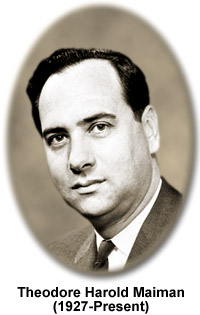Theodore Harold Maiman
(1927-Present)

Theodore Maiman is best known for constructing the world’s first laser, a device that has transcended the field of optics to find a diversity of applications in the modern world. Maiman was born on July 11, 1927 in Los Angeles, California. His father, an electrical engineer who carried out experimentation of his own, apparently had a significant impact on Maiman’s interests. In order to accumulate the financial resources necessary to attend college, the younger Maiman repaired and refurbished household appliances and other electrical equipment. His exertions enabled him to pursue a bachelor of science at the University of Colorado, a degree that was awarded to him in 1949. Subsequently, Maiman transferred to Stanford University to pursue graduate studies, earning a master’s degree in 1951, followed by a doctorate in physics four years later.
His formal education complete, Maiman entered the professional realm by undertaking a position with Hughes Research Laboratories in Miami, Florida. There he began investigating the work previously completed on the maser by Charles H. Townes and other contemporary scientists. Townes had successfully amplified microwaves in the early 1950s, but although he and several other researchers were busily developing the concepts involved in stimulating emission at shorter wavelengths, no one had actually built a device that was capable of the feat. The realization of this goal became the driving force behind Maiman’s work.
In May of 1960, Maiman built the first working laser using a synthetic ruby rod silvered at both ends to reflect light. Small enough to be held in the palm of the hand, when the atoms in the rod were excited by an intense beam of light from a xenon lamp, a release of energy was initiated and an internal chain reaction occurred that caused the energy to bounce back and forth within the rod. When the energy built up to a certain level, it escaped from one end of the ruby rod to form an intense beam of monochromatic light centered at 694.3 nanometers. Extremely concentrated and able to traverse extensive distances without dispersion, the apparatus, later termed the laser (Light Amplification by Stimulated Emission of Radiation), quickly found a wide array of usage.
Realizing the great number of possibilities, Maiman soon left the Hughes Research Laboratories to pursue his work independently. He established his own company, the Korad Corporation, for the research and production of lasers in 1962, followed by the organization known as Maiman and Associates, which concentrated on lasers and other optical issues, in 1968. Maiman founded yet another company in 1972, establishing the Laser Video Corporation to develop video display systems powered by lasers. Four years later, however, Maiman once again began exercising his talents for someone else’s firm, assuming the role of vice president for advance technology at TRW Electronics.
In addition to his various business positions, Maiman has been an active member of many professional societies, such as the Optical Society of America and the National Academy of Engineering. Also, for his significant contributions to science, he has been bestowed a number of honors. Among these are the Ballantine Medal of the Franklin Institute (1962), the Buckley Solid State Physics Prize of the American Physical Society (1966), and the Wood Prize of the American Optical Society (1976).
